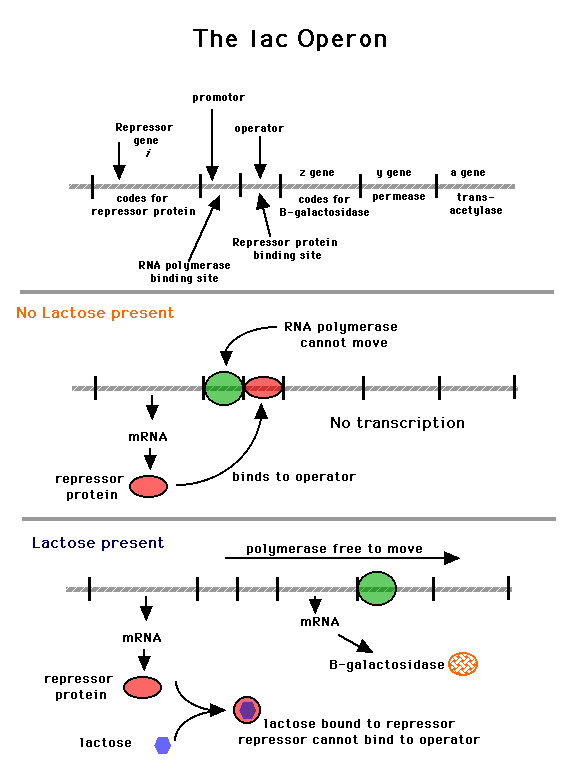|
Recall : a
gene only holds information to make proteins. Many proteins are enzymes
that work together to join or cleave existing molecules or synthesize
other nonprotein molecules such as carbohydrates, lipids, amino acids
nucleotides, etc......
.
 The E. coli
bacteria is a common bacteria
that lives in the animal G.I. tract. It is frequently studied because of
its simplicity and easy care in the lab. (lab rat of
microbes) The E. coli
bacteria is a common bacteria
that lives in the animal G.I. tract. It is frequently studied because of
its simplicity and easy care in the lab. (lab rat of
microbes)
E. coli can synthesize all of its organic molecules using only
glucose (or other sugars) and elements such as N, P,
K etc.
Most of E. coli's genes are unregulated, that is, they are able to express
themselves at all times.
Other complex genes such as the lac
operon are INDUCIBLE , meaning, "on"
only when their product
(protein or byproduct of the protein) is required by the cell and
"off"
(suppressed) when that molecule is no longer needed or is
presently abundant.
Examples - a) if tryptophan is
added to the bacteria's growth media then it will stop making the enzymes
required to make more tryptophan. This shows that in some cases the final
products of gene expression can halt gene expression by negative end
product feedback.
b) If E. coli growing in a medium where they are respiring glucose
are then moved to a medium with lactose
(disaccharide) only then
they stop dividing (become
quiescent) and only after a period time begin to respire
using
lactose as metabolic fuel. During the quiescent period the cells began to
manufacture enzymes required to utilize lactose instead of glucose. The cells
resume normal functions begin rapidly dividing again their metabolism
fueled by lactose......
What happened?? ......... the presence of
lactose initiated the expression of the 3 genes (below)
that are associated with lactose metabolism ......... but how??
-
permease - an enzyme that transports lacose across the cell
membrane in to the cell
-
beta-galactosidase - hydrolyses lactose
(disaccharide) into
glucose and galactose (monosaccharides)
-
transacetylase - function is still unknown
all 3 proteins are transcribed from the same composite DNA segment
called an operon only
seen in prokaryotes (eukaryotes use a one protein
approach) .
 The lac
(lactose)
operon
One way to regulate gene
expression is to regulate transcription (making of
mRNA).
In the absence of lactose a lac repressor is
bound to an operator (which controls a promoter)
on the lac operon thus preventing the RNA polymerase from
binding to the operon.
>>>This prevents RNA polymerase from synthesizing the
mRNA for the lac operon and thus synthesis of the 3 enzymes needed for lactose
metabolism.
>>>When lactose appears in E. coli's environment it binds to, and disables, the
lac repressor inducing the translation of the operon mRNA to proceed and
subsequent translation (production) of the 3 operon proteins that are
essential for lactose metabolism.
animation
|
1
and quiz
|
2 |
3
|
quiz

<<<<<<<<<<<Your notes >>>>>>>

The lac operon
is a composite unit and consists of ......
-
the repressor protein gene
-
the promoter region of DNA
-
the operator region of DNA
-
as well as the Z,
Y, and A genes that code for the 3 proteins described earlier
KNOW THESE TERMS Operon
- a segment of DNA that is used to code for the proteins used to
metabolize a molecule
LAC Operon - a segment of DNA used to
metabolize LACtose
Repressor gene - produces a repressor
protein that prevents RNA polymerase from binding to the operon
Repressor Protein - attaches to operator
site on operon and prevents RNA polymerase from attaching and transcribing
the genes when the inducer (such as lactose) attaches to it the repressor
falls away allowing RNA polymerase to attach to the operator
Promoter - ( RNA Polymerase binding
site) region of DNA that the RNA polymerase initially binds to
use the animations to understand the temporal sequence of events that
control activation of the operon |

 The E. coli
bacteria is a common bacteria
that lives in the animal G.I. tract. It is frequently studied because of
its simplicity and easy care in the lab. (lab rat of
microbes)
The E. coli
bacteria is a common bacteria
that lives in the animal G.I. tract. It is frequently studied because of
its simplicity and easy care in the lab. (lab rat of
microbes)

